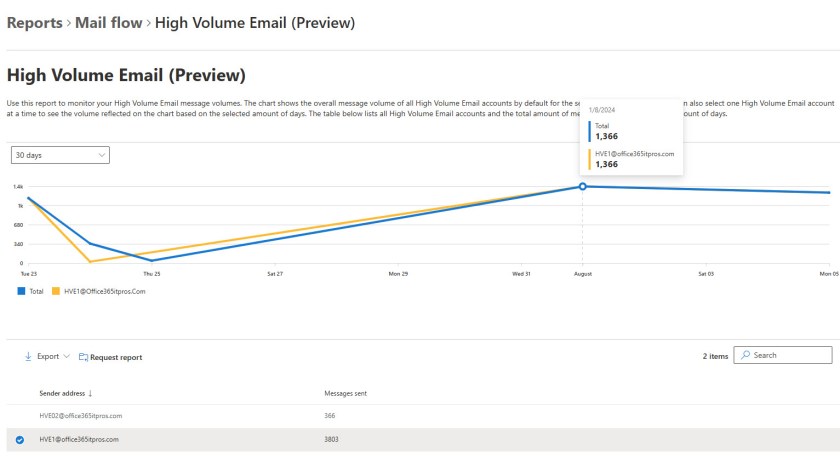Table of Contents
HVE and ECS Compete for Different Customers of Microsoft Cloud Email Services
I need to apologize to some of the subscribers to the Office 365 for IT Pros eBook. Over the last few weeks, I’ve been using you as the targets for emails sent using Exchange Online High-Volume Email (HVE) and the Azure Email Communication Service (ECS).
Both solutions focus on sending large quantities of email. HVE is more internal-focused but can handle external messages. HVE is part of Exchange Online and intended to help customers move off on-premises servers to handle traffic generated by multi-functional devices and applications. ECS is a standalone offering that can handle large volumes of external email such as newsletters, subject to thresholds set by Microsoft. According to Microsoft, ECS is very popular and handles large amounts of messages daily.
HVE is in preview and is free to use today. When it’s generally available, HVE will likely cost for some traffic. ECS is already a pay-as-you-go service that must be funded by an Azure subscription.
Seeking Test Email Targets for Microsoft Cloud Email Services
When setting out to test the effectiveness of emailing solutions, you need large numbers of target recipients. Little is to be learned by sending a couple of messages to a few internal recipients. To run a better trial, I decided to use HVE and ECS to send reminder messages to subscribers of the 2024 edition of the Office 365 for IT Pros eBook to ask if they wanted to take advantage of an offer to extend their subscription. Sending email to ask people to buy something or take out a subscription seemed like a pretty good scenario to test the useability of HVE and ECS.
Comparing HVE and ECS
Overall, HVE is easier to use. Less setup is required, and the PowerShell used to generate and submit messages is based on the old (deprecated) Send-MailMessage cmdlet. No shortage of articles can be found on the internet to tell you how to use Send-MailMessage. Because of the need to provide an email service for apps and devices, HVE uses a restricted form of basic authentication with the SMTP AUTH protocol. Support for modern authentication is coming, but using basic authentication for internal messages will make the switchover to HVE much easier.
HVE reporting (Figure 1) is basic. More comprehensive reporting is built into ECS. In both cases, feedback from sent messages is minimal, so figuring out what happened to messages is tough. ECS can tell you the number of messages it failed to send but HVE is silent on this point. However, HVE is in preview and Microsoft says that they will deliver better reporting when the solution is generally available.

The ECS setup is more complicated if you’re unaccustomed to dealing with Azure resources and billing. ECS uses an Entra ID app for authentication and to prove that an app (like a PowerShell script) has the right to submit messages to the service. Creating and submitting messages to ECS is similar to using Graph-based cmdlets like Send-MgUserMail. Some differences exist because a different API is used, but the basics of building a hash table of message parts and converting it to JSON before sending won’t be unfamiliar.
Throttling and thresholds were the biggest issue I encountered with both ECS and HVE. It took a little while to find where limits applied in practice and to investigate ways around them. Microsoft has a documented process for applying for higher limits for ECS but my ability to navigate the process failed and I never managed to achieve a higher threshold. Microsoft is careful with HVE while it is in preview and some limitations (like the 2,000 external recipients per tenant daily) are hardcoded and won’t change until the software reaches general availability.
Testing of both Microsoft Cloud Email Services Proves Valuable
As always, the opportunity to conduct realistic tests over a sustained period proved invaluable in gaining an understanding about how HVE and ECS work. In my case, sending thousands of reminder messages to Office 365 for IT Pros subscribers certainly taught me a lot. You can read more about my experiences in articles covering HVE and ECS in-depth. Other articles about HVE and ECS are available on the internet, but most are content to send just a few test messages and then declare success. That’s no way to exercise a high volume email system.
If you’re interested in one of these services, my advice is to spin up both and test using a sample of messages that your organization needs to send. Exchange Online tenants will, I think, select HVE, but I can see why ECS has its attractions especially if the focus is on sending large quantities of email to external recipients. Beauty is in the eye of the mail sender.
Learn about using Exchange Online and the rest of Office 365 by subscribing to the Office 365 for IT Pros eBook. Use our experience to understand what’s important and how best to protect your tenant.